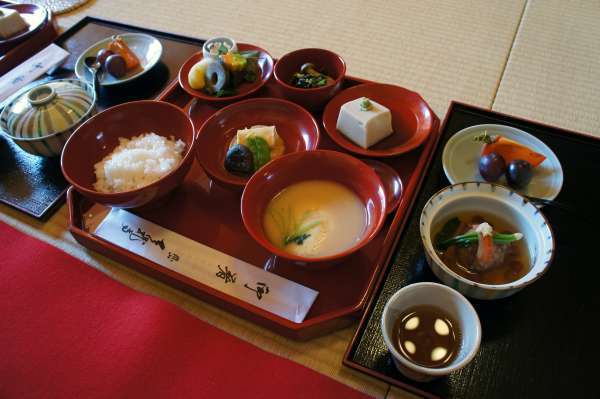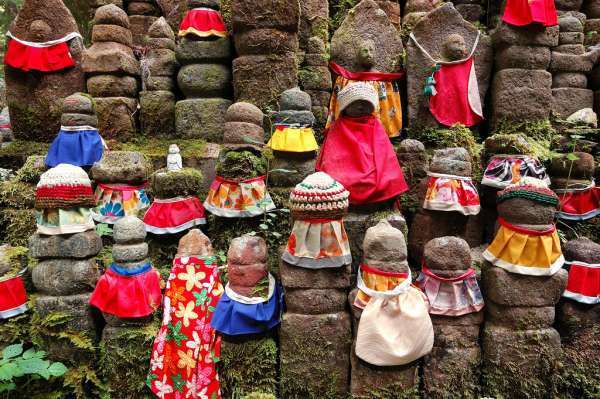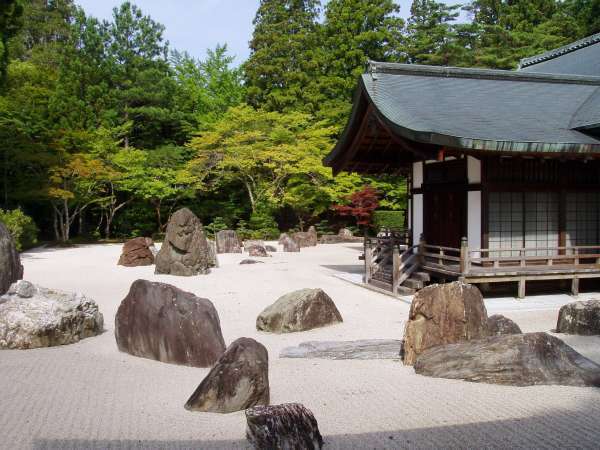If you are planning a trip to the sacred mountains of Wakayama, then why not experience a night at a historic temple, or learn about the origin of Shingon Buddhism. There is something for everyone here, so read on for our top four Mount Koya highlights:
Koyasan Shukubo

(image by upload.wikimedia.org)
Do you know that you can lodge at historic temples? In Koyasan, there are countless lodging facilities, called Shukubo, in temples where that offer a valuable chance to spend time with monks.
Currently, there are 117 temples in Koyasan, of which 52 have Shukubo lodging facilities. Each Shukubo has different characteristics, including Buddhist cuisine, a variety of guest rooms, baths and gardens. When lodging at Shukubo, you will be able to observe the morning duties of the monks, and you can enjoy a relaxed tour of the countless historical temples. You will experience unique aspects of Japanese culture at these precious lodges, where you can also enjoy Buddhist cuisine (a cuisine based on the Buddhist teachings that forbid killing of any kind, and that only uses grains, beans and vegetables without any meat or fish), and you can stay in a traditional Japanese-style room with a futon rolled out on tatami straw mats.
Many foreign travellers come to Eko-in, a pilgrim’s lodge near the inner sanctuary where guests can experience Ajikan meditation and sutra copying for free. Ichijo-in is located in the middle of Koyasan, which is convenient for visiting temples where you can enjoy water-feature gardens with colored carp, and grand temple buildings. Jimyo-in is also centrally located, and you can eat Koyasan’s famous freeze-dried tofu and sesame tofu at the temple, which is encompassed by a 6600 square meter garden. For access to Koyasan, we recommend taking the special Tenku train service between Hashimoto Station and Koyasan Station. This train journey takes about 50 minutes, giving you opportunity to thoroughly and calmly enjoy the scenery.
Admission: Various
- Guidebook from Planetyze about Koyasan Shukubo
- Reviews from TripAdvisor about Koyasan Shukubo
- Tours of Koyasan Shukubo
Okunoin Temple

(image by flickr.com)
Known as a power spot, Okunoin Temple is where the founder of the Shingon sect, Kobo Daishi (the monk Kukai), performed the ultimate ascetic training in which he practiced austerity to the point of death. To get to Okunoin Temple, visitors walk along a 2km approach to the temple from Ichi-no-hashi Bridge to the mausoleum. According to the tradition, Grand Master Kukai comes to this Ichi-no-hashi Bridge to greet you at your arrival and then later to see you off. For this reason, visitors bring their hands together and bow once toward this bridge as a form of prayer. Along the approach are more than 200,000 monuments including graves, prayer steles and memorials. The temple is also well known as the spot of the graves of famous, powerful feudal lords and samurai warriers who fought more than 500 years ago including the grave of Nobunaga Oda and the memorial pagodas of Shingen Takeda and Masamune Date. The remains and personal belongings of the deceased family members have been brought to the sanctuary of Mount Koya for generations by people praying for the rebirth of the deceased ones in the Pure Land.
The temple has been collecting people who make wishes and prayers for the repose of the departed soul, and by that, it has been collecting spiritual energy. This sacred spot has come to be revered by people of all social levels–members of the Imperial court, aristocrats, samurai worriers, and the commons–and it has prospered as a place of comfort and support for people regardless of their sect. Pilgrims, who are called ohenro-san, pray in gratitude to Grand Master Kukai in front of his mausoleum at Mount Koya Okunoin Temple before departing on a pilgrimage to express their joy of “kechien (to make a religious connection)” and after finishing it to report “kechigan (to finish ascetic practices for making a wish).” The temple premises is mystic and sublime; the gigantic cedar trees and moss-covered stone pagodas speak of the temple’s 1,200 years of history.
Admission: Free
- Guidebook from Planetyze about Okunoin Temple
- Reviews from TripAdvisor about Okunoin Temple
- Tours of Okunoin Temple
Kongobuji Temple

(image by upload.wikimedia.org)
At the spacious and gracious, approx. 160,000 square meters premises of the Kongobuji temple, the headquarters of Mount Koya Shingon Buddhism, visitors can leisurely enjoy a variety of rooms and gardens. The area collectively called Kongobuji temple includes the Main Hall, the Head Monk’s Room, the Inner Hall, the Annex, the New Annex, the Drawing Room, the New Drawing Room, the Scripture Storage, the Bell Tower, the Shinzen Hall, the Goma Prayer Hall, the Ajikan Meditation Hall, and a tea house as well as the Banryutei garden which is one of Japan’s largest stone gardens. Take your time to observe the wonderful artwork on transoms andfusuma sliding doors. At the New Annex, visitors can listen to sermons given by monks in a casual atmosphere while enjoying Japanese style tea and confections. While at this temple, we highly recommend participating in the ajikan meditation session. The term ajikan refers to the breathing method and meditation method of the Shingon Buddhism; it is a Buddhist training method to unify with the Buddha within you. Become tranquil and let the time pass slowly at the meditation hall surrounded by nature. There is no need to make a reservation to participate in the ajikan session and you are welcome even if you are a complete beginner. Detailed and supportive instructions are given to participants by the monks. People around the world are increasingly taking interest in meditation. Some say meditation is beneficial for maintaining your health. Mount Koya, a Buddhist temple site with 1,200 years of history, is definitely a great place to try out meditation.
Admission: Adult: ¥ 500 / Child: ¥ 200
- Guidebook from Planetyze about Kongobuji Temple
- Reviews from TripAdvisor about Kongobuji Temple
- Tours of Kongobuji Temple
Danjo Garan

(image by upload.wikimedia.org)
Garan refers to a facility for Buddhist practice and/or meditation for monks. Garan is a collective name for an area that consists of seven main facilities: a main hall, a pagoda, a lecture hall, a bell tower, a scripture storage, monks’ quarters, and a dining hall. Danjo Garan is part of Mount Koya, the center of Shingon Buddhism. Along with Okunoin (the inner sanctuary), Danjo Garan is one of the two great sacred spots of Mount Koya. Dotted with nearly 15 buildings, Danjo Garan is a must see tourist attraction. Enjoy a leisurely stroll through the sacred air of Danjo Garan.
Enjoy the seasonal views of Mount Koya – cherry blossoms in spring, young tender leaves in summer, colorful leaves in fall, and snow in winter. Among the many highlights, worthy of special note is the large pagoda Konpondaito, the symbol of Mount Koya. The pagoda’s interior embodies the great monk Kukai (Kobo Daishi)’s idea of mandala. Visitors can enter the building to view Buddhist statues and wall paintings. Another highlight is the main hall (Kondo) which serves an important role as the headquarters of all Buddhist facilities in Mount Koya. Don’t miss the Buddhist themed paintings by Buzan Kimura decorated inside this main hall. Just another reason for visiting Mount Koya, coming up soon is the unveiling of the Chumon Gate which is now being reconstructed. Impressive Buddhist statues currently in temporary storage and newly created Buddhist statues will be placed inside this gate.
Admission: Adult: ¥ 500 / Child: ¥ 200
- Guidebook from Planetyze about Danjo Garan
- Reviews from TripAdvisor about Danjo Garan
- Tours of Danjo Garan